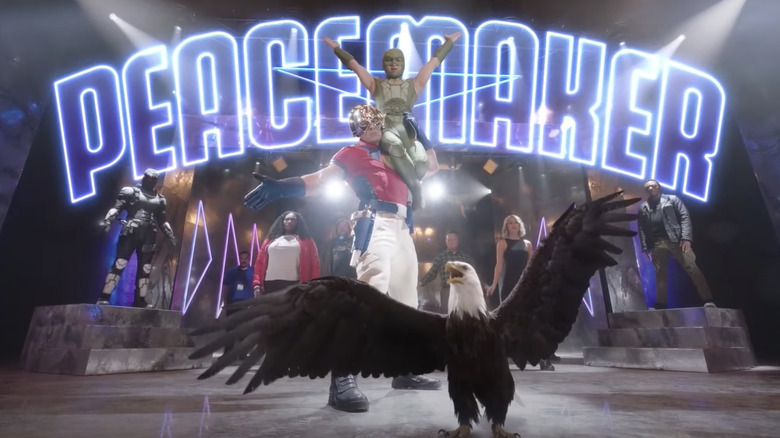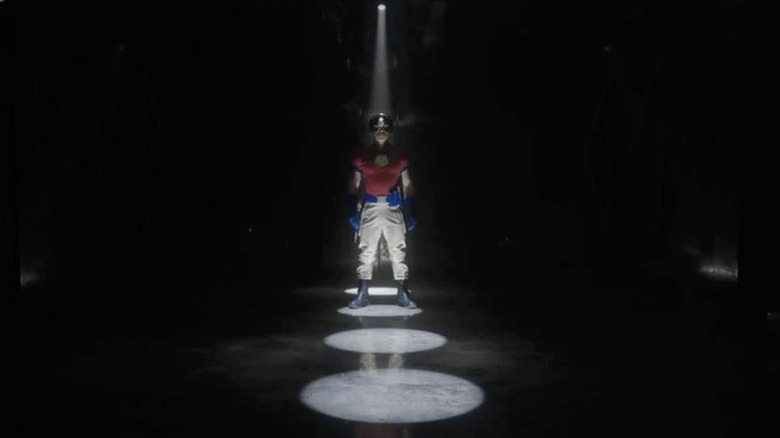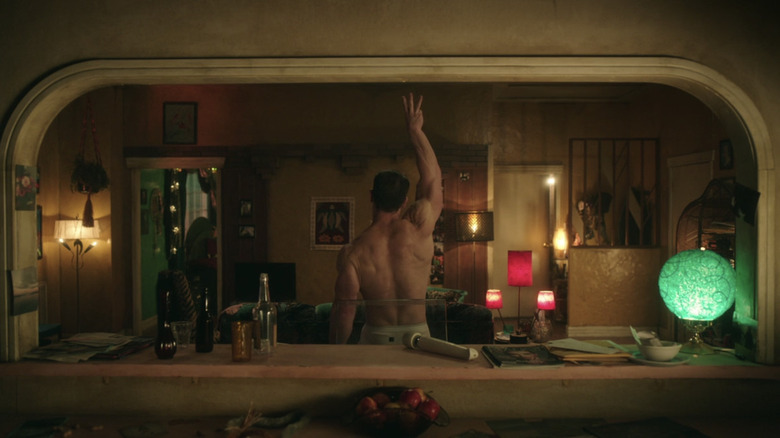A Step By Step-Ball-Change Guide To The Peacemaker Intro Choreography
James Gunn is not your typical comic book adaptation director, and the spin-off series "Peacemaker" is no exception. Filled with gruesome violence, NSFW dialogue, a refreshingly pointed political message that racists are villains who deserve to have their asses handed to them, and fearless critique of DC Comics' golden heroes, "Peacemaker" is Gunn at his absolute best. In a stroke of pure genius, the "Peacemaker" opening credits sequence capture the essence of the series by introducing the characters not by some deeply heroic slow-motion sequence where everyone looks intimidating and inspirational, but rather through a deadpan dance number set to Wig Wam's "Do Ya Wanna Taste It."
As a life-long hair metal fan who went to school to study theatre and film, this spoke to me on a nearly religious level. Look, I'm a massive movie geek and have spent the last decade plus of my life analyzing films, but before all of that I was a world champion baton twirler and dancer. With the exception of big movie musicals like "West Side Story," it's not often that I get the opportunity to geek out about choreography and prove to my parents that they didn't waste nearly two decades of their life attending recitals, competitions, and practices. The brilliant Charissa-Lee Barton choreographed one hell of an opener, and I'm here to speculate wildly about the style and inspirations injected into these killer moves.
A Brief Introduction to Charissa Barton
Charissa Barton is a ridiculously talented choreographer who has worked for The Grammys, American Ballet Theater, Dance Camera West, BC Beat, the Juilliard School, is the co-owner of Axis Connect, and has done so much more. She's also married to Alan Tudyk, which I know will be of huge interest to many, but Barton deserves her flowers for bigger reasons than who she calls husband. She's known for her contemporary jazz work, but she clearly has a solid grasp on a variety of styles, because they're all on display in the opening dance sequence.
According to "Peacemaker" star Jennifer Holland, Charissa took Gunn's concept of a surreal and robotic dance with the actors remaining emotionless, and crafted the piece from there. The actors would work with Barton on the days they weren't filming, and the opening sequence was shot with the entire cast together in the same room: a high school auditorium. Most of the cast of "Peacemaker" are not the strongest dancers, and Barton's choreography was clearly constructed with everyone's varying skill level in mind. Throughout the press tour of the show, most of the actors have agreed that the hardest part was not the actual choreography, it was performing it with a straight face. Just as this is not your typical superhero series, this isn't your typical opening dance number, either. They're not hamming it up for the crowds in the nose-bleeds, this is serious business.
A 5-6-7-8!
Right of the bat, I couldn't help but notice that main combination throughout reminded me of the choreography used in the music video "Skibidi" by the Russian rave band Little Big. The two have similar styles of using bent elbows to give the performer a square shape of intensity, and a sharp, intentional pattern of movement. The above-the-head arm motions remind me a lot of the style of David Toguri, who is also responsible for choreographing "The Time Warp" from "The Rocky Horror Picture Show."
Modern dance techniques of using arm placement to tell a story are on great display, with it all juxtaposed beautifully against the smoothness of swiveling hips and John Cena's circular lasso-like arm movements. Between the dominant arms and high knees, there are moments of groin thrusts and chest pulses, an excellent way to capture the innate sexuality of the hair metal music coursing through the veins of the show. At one point, their bladed fingers and closed fists explode into a jazz hand, transforming the rigid and robotic movements into the jazzy precision of Bob Fosse.
After each group of characters have been introduced, they all meet together for a show-stopping group version of the original sequence with mild modifications. The group moves in tandem, waving their arms in unison, looking like the Dr. Zoidberg scuttle. As the camera shifts around, individual performers are highlighted in what looks like a choreographed freestyle, before hitting the final pose, with Judomaster on top of Peacemaker's shoulders like every golden age musical act one ending, or taking a page from Cena's wrestling career and emulating Miss Elizabeth and Macho Man.
Let's Dance!
I highly doubt Barton's inspirations came from any of the nonsense places I listed, but the beautiful thing about dance is that it can be interpreted differently by anyone viewing or performing. I fully admit that in the course of writing this article, I've memorized about two-thirds of the total routine. When I move my body, I'm definitely bringing some of the bouncy energy of Freddie Stroma's Vigilante but the precision of Jennifer Holland's Harcourt. Old habits die hard, I guess.
The same way that Little Big's "Skibidi" ended up as a playable song on the popular video game "Let's Dance," I'm hoping that Barton's brilliant choreography for "Peacemaker" will share a similar trajectory, or at least become a TikTok challenge. Dancing is good for the body, mind, and soul, and with Barton's choreography being accessible for even the most novice dancers, I hope that people feel inspired to let the power of "Peacemaker" move them and groove them. For those that are worried about looking silly or doing it wrong, have no fear. There's no wrong way to dance. If the choreography is too intimidating, you can always pull a Chris Smith and just groove your face off into a Hitachi magic wand to "I Don't Love You Anymore" by The Quireboys in your underwear. Like I said, there's no wrong way.


